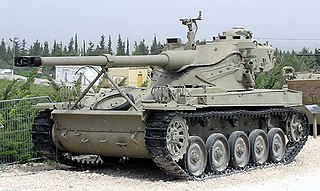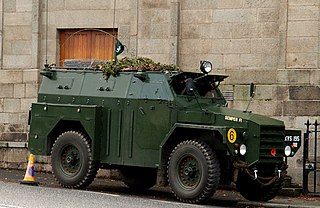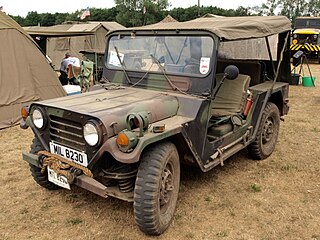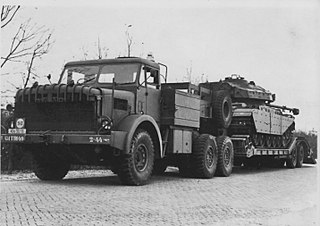 W
W59-16 Light Tank was a former Chinese light tank design which was developed during the late 1950s, originally intended as one of the "tributes to the 10th anniversary of the founding of the PRC". Within the design plans, the intended weight was planned to be approximately 16 mt with a 76 mm tank gun. However, because this tank was too weak to fight against the western tanks at that time, it was eventually set aside by the military.
 W
WThe FV601 Saladin is a six-wheeled armoured car developed by Crossley Motors and later manufactured by Alvis. Designed in 1954, it replaced the AEC Armoured Car in service with the British Army from 1958 onward. The vehicle weighed 11 tonnes, offered a top speed of 72 km/h, and had a crew of three. Saladins were noted for their excellent performance in desert conditions, and found favour with a number of Middle Eastern armies accordingly. They were armed with a 76 mm low-pressure rifled gun which fired the same ammunition as that mounted on the FV101 Scorpion.
 W
WThe FV603 Saracen is a six-wheeled armoured personnel carrier built by Alvis and used by the British Army. It became a recognisable vehicle as a result of its part in the policing of Northern Ireland as well as for its role in the South African government's enforcement of apartheid. It is still in use in secondary roles in some countries.
 W
WThe AMX-13 is a French light tank produced from 1952 to 1987. It served with the French Army, as the Char 13t-75 Modèle 51, and was exported to more than 25 other nations. Named after its initial weight of 13 tonnes, and featuring a tough and reliable chassis, it was fitted with an oscillating turret built by GIAT Industries with revolver type magazines, which were also used on the Austrian SK-105 Kürassier. Including prototypes and export versions, there are over a hundred variants including self-propelled guns, anti-aircraft systems, APCs, and ATGM versions.
 W
WThe ZiS-485, army designation BAV, is a Soviet amphibious transport, patterned after the WWII American DUKW.
 W
WThe Bedford RL was the British military's main medium lorry (truck), built by Bedford, from the mid-1950s until the late 1960s. They superseded the Bedford QL.
 W
WThe BRDM-1 is a Soviet amphibious armored scout car. It was the first purpose-built Soviet reconnaissance vehicle to enter service since the BA-64 and was built on the chassis and drive train of the BTR-40 armored personnel carrier. It is the world's first mass-produced combat vehicle of its class.
 W
WThe BTR-40 is a Soviet non-amphibious, wheeled armoured personnel carrier and reconnaissance vehicle. It is often referred to as the Sorokovka in Soviet service. It is also the first mass-produced Soviet APC. It was eventually replaced in the APC role by the BTR-152 and in the scout car role by the BRDM-1.
 W
WThe BTR-152 was a six-wheeled Soviet armored personnel carrier, built on the chassis and drive train of a ZiS-151 utility truck. It entered service with a number of Warsaw Pact member states beginning in 1950, and formed the mainstay of Soviet motor rifle battalions until the advent of the amphibious BTR-60 series during the 1960s.
 W
WThe Charioteer Tank, or FV4101 Tank, Medium Gun, Charioteer was a post-war British armoured fighting vehicle. The vehicle was produced in the 1950s to up-gun units of the Royal Armoured Corps continuing to use the Cromwell tank during the early phases of the Cold War. The vehicle itself was a modified Cromwell with a more powerful gun installed in a relatively lightly armoured two-man turret.
 W
WThe Dodge M37 3⁄4-ton 4x4 truck (G741) was Dodge's follow-up to their successful WC Series from World War II. Introduced in 1951, it was used extensively by the United States armed forces during the Korean war. In the 1970s, they were replaced by the Commercial Off The Shelf (COTS) based 1 1⁄4-ton trucks Kaiser M715, and Dodge's M880/M890 series (1970s).
 W
WThe Ferret armoured car, also commonly called the Ferret scout car, is a British armoured fighting vehicle designed and built for reconnaissance purposes. The Ferret was produced between 1952 and 1971 by the UK company Daimler. It was widely adopted by regiments in the British Army, as well as the RAF Regiment and Commonwealth countries throughout the period.
 W
WThe FV1620 Humber Hornet was a specialised air-deployable armoured fighting vehicle designed to carry the Malkara, an anti-tank guided missile developed by Australia and the United Kingdom.
 W
WThe Humber Pig is a lightly armoured truck used by the British Army from the 1950s until the early 1990s. The Pig saw service with the Royal Ulster Constabulary (RUC) chiefly as an armoured personnel carrier from late 1958 until early 1970. The Pig became particularly well known from its presence on the streets of Northern Ireland during the worst of the Troubles.
 W
WLARC-LX, or as it was originally designated BARC is a welded steel-hulled amphibious cargo vehicle.
 W
WThe M35 2 1⁄2-ton cargo truck is a long-lived 2½-ton 6×6 cargo truck initially used by the United States Army and subsequently utilized by many nations around the world. Over time it evolved into a family of specialized vehicles. It inherited the nickname "Deuce and a Half" from an older 2 1⁄2-ton truck, the World War II GMC CCKW.
 W
WThe M42 40 mm Self-Propelled Anti-Aircraft Gun, or "Duster," is an American armored light air-defense gun built for the United States Army from 1952 until December 1960, in service until 1988. Production of this vehicle was performed by the tank division of the General Motors Corporation. It used components from the M41 light tank and was constructed of all-welded steel.
 W
WThe M46 Patton was an American medium tank designed to replace the M26 Pershing and M4 Sherman. It was one of the U.S Army's principal medium tanks of the early Cold War, with models in service from 1949 until the mid-1950s. It was not widely used by U.S. Cold War allies, being exported only to Belgium, and only in small numbers to train crews on the upcoming M47 Patton.
 W
WThe M47 Patton was an American main battle tank, a development of the M46 Patton mounting an updated turret, and was in turn further developed as the M48 Patton. It was the second American tank to be named after General George S. Patton, commander of the U.S. Third Army during World War II and one of the earliest American advocates of tanks in battle.
 W
WThe M48 Patton is an American first generation main battle tank (MBT) introduced in February 1952, being designated as the 90mm Gun Tank: M48. Mrs. Beatrice Ayer Patton, wife of the late General George S Patton christened it as a Patton. It was designed as a replacement for the M26 Pershing, M4 Sherman variants and M46 Pattons used in the Korean War, and as the successor to the M47 Patton. Nearly 12,000 M48s were built, mainly by Chrysler and American Locomotive Company, from 1952 to 1961. The M48 underwent many design modifications and improvements during its production life. This led to a wide variety of suspension systems, cupola styles, power packs, fenders and other details among individual tanks. The early designs, up to the M48A2C, were powered by a gasoline engine. The M48A3 and A5 versions used a diesel engine, however gasoline engine versions were still in use in the US Army National Guard through 1968 and through 1975 by many West German Army units. Numerous examples of the M48 saw combat use in various Arab–Israeli conflicts and the Vietnam War. Beginning in 1959, most American M48A1s and A2s were upgraded to the M48A3 model.
 W
WThe Flame Thrower Tank M67 is an American medium flame tank that was briefly used by the U.S. Army, and later by the U.S. Marine Corps during the Vietnam War. It was the last flamethrower tank used in American military service.
 W
WThe Truck, Utility, ¼-Ton, 4×4, M151 or simply M151 was the successor to the Korean War M38 and M38A1 jeep Light Utility Vehicles. The M151 had an integrated body design which offered a little more space than prior jeeps, and featured all-around independent suspension with coil springs. It has since been replaced by the larger AM General HMMWV in most utility roles in frontline use. With some M151A2 units still in U.S. military service in 1999, the M151 series achieved a longer run of service than that of the World War II/Korean War-era MB/GPW, M38, and M38A1 series combined.
 W
WThe Panhard AML is a fast, long-ranged, and relatively cheap armoured car with excellent reconnaissance capability. Designed on a small, lightly armoured 4×4 chassis, it weighs an estimated 5.5 tonnes, and thus suitable for airborne deployment. Since 1959 AMLs have been marketed on up to five continents; several variants remained in continuous production for half a century. These have been operated by fifty-four national governments and other entities worldwide, seeing regular combat.
 W
WThe PT-76 is a Soviet amphibious light tank that was introduced in the early 1950s and soon became the standard reconnaissance tank of the Soviet Army and the other Warsaw Pact armed forces. It was widely exported to other friendly states, like India, Iraq, Syria, North Korea and North Vietnam. Overall, some 25 countries used the PT-76.
 W
WThe Mighty Antar was a heavy-duty 6×4 tractor unit built by Thornycroft from the late 1940s onwards. For some decades it was the standard tank transporter of the British Army and was also used by other nations. It was powered by a shortened V8 land version of the V12 Merlin Aircraft engine modified to run on diesel and known as the Rolls-Royce Meteorite.
 W
WThe Type 59 main battle tank is a Chinese-produced version of the Soviet T-54A tank, an early model of the ubiquitous T-54/55 series. The first vehicles were produced in 1958 and it was accepted into service in 1959, with serial production beginning in 1963. Over 10,000 of the tanks were produced by the time production ended in 1980 with approximately 5,500 serving with the Chinese armed forces. The tank formed the backbone of the Chinese People's Liberation Army until the early 2000s with an estimated 5,000 of the later Type 59-I and Type 59-II variants in service in 2002.
 W
WThe U.S. Military M274 Truck, Platform, Utility, 1/2 Ton, 4X4 or "Carrier, Light Weapons, Infantry, 1/2 ton, 4x4", also known as the "Mule", "Military Mule", or "Mechanical Mule", is a 4-wheel drive, gasoline-powered truck/tractor type vehicle that can carry up to 1/2 tons off-road. It was introduced in 1956 and used until the 1980s.
 W
WThe M41 Walker Bulldog, officially 76-mm Gun Tank, M41, was an American light tank developed for armed reconnaissance purposes. It was produced by Cadillac between 1951 and 1954 and marketed successfully to the United States Army as a replacement for its aging fleet of World War II vintage M24 Chaffee tanks. Although engineered as a reconnaissance vehicle, the M41's weight and armament also made it effective in the close infantry support role and for rapid airborne deployments. Upon entering US service, all M41s received the designation Little Bulldog and subsequently, Walker Bulldog after the late General Walton Walker, who was killed in a Jeep accident in 1950. The M41 was the first postwar American light tank to see worldwide service, and was exported in considerable numbers by the United States, particularly to Asia.
 W
WThe Willys MC, formally the 1⁄4-Ton, 4 x 4, Utility Truck M38, or the G‑740 by its U.S. Army Standard Nomenclature supply catalog designation, is a quarter-ton four-wheel drive military light utility vehicle made by Willys between 1949 and 1952. It replaced, and succeeded the World War II Willys MB and Ford GPW models, with a total production of some 50,000 units — less than one tenth the number of WWII models built. Unlike during WWII, Ford was no longer involved in the production.
 W
WThe Willys MD, formally the M38A1 Truck, Utility: 1/4 ton, 4x4, or the G‑758 by its U.S. Army Standard Nomenclature supply catalog designation, was a four-wheel drive, military light utility vehicle, made by Willys and Willys Motors / Kaiser Jeep from 1952 to 1971. It was widely procured by the U.S. military from 1952 until 1957, after which U.S. purchases were reduced to the U.S. Marine Corps. The Marine version had minor differences from the units used by other branches.